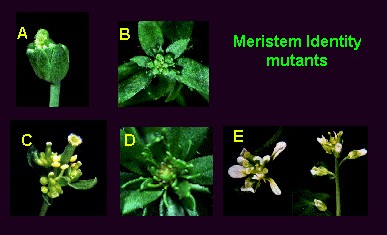| Flower Meristem Identity |
Meristem
Identity Genes can be divided into two distinct classes.
|
Related Links |
| In general, mutations in meristem identity genes such as LFY and AP1 lead to a partial conversion of flowers into shoots, whereas mutations in TFL cause both early flowering and premature conversion of the normally indeterminate shoot meristem into a flower meristem, with the resulting formation of a terminal flower. TFL can be considered a negative spatial regulator of both LFY and AP1, since mutations in TFL lead to ectopic activity of both LFY and AP1 and the tfl phenotype can be largely suppressed if both the LFY and AP1 genes are inactivated. Although lfy and ap1 mutants display partial conversion of flowers into shoots, this phenotype is dramatically enhanced in lfy ap1 double mutants such that a nearly complete conversion of flowers into shoots occurs. | |
 |
Meristem
Identity mutants A. lfy flower B. lfy inflorescence C. ap1 flower D. lfy ap1 inflorescence E. tfl flower & whole plant |
| Additionally, LFY and AP1 are each sufficient to promote flower initiation, since ectopic expression of either gene from the CaMV35S promoter largely replaces shoots with individual flowers. | |
| The role of the CAL gene largely overlaps with that of AP1, such that cal single mutants are not significantly different from wild-type, whereas mutations in the CAL gene dramatically enhance the phenotype of ap1 mutants causing a massive proliferation of "inflorescence-like' meristems in place of flowers. |
ap1cal double mutant |
| The phenotypes conferred by
mutations in meristem identity genes are sensitive to environmental factors such as
temperature and day length. For example, short days or low temperatures, which attenuate
floral induction, enhance the phenotype of flower meristem identity mutants but suppress
the phenotype of tfl mutants. Thanks to Detlef Weigel for the lfy and ap1 lfy mutant photos. |
|
| Selected
References: Alvarez J., Guli C.L., Yu X.-H., Smyth D.R. (1992) TERMINAL FLOWER : a gene affecting inflorescence development in Arabidopsis thaliana. Plant J. 2:103-16 Bowman, J.L., Alvarez, J., Weigel, D., Meyerowitz, E.M., and Smyth, D.R. (1993). Control of flower development in Arabidopsis thaliana by APETALA1 and interacting genes. Development, 119:721-743. Bradley D, Carpenter R, Copsey L, Vincent C, Rothstein S, Coen E. (1996) Control of inflorescence architecture in Antirrhinum. Nature 379, 791-797. Coen, E.S., Romero, J.M., Doyle, S., Elliot, R., Murphy, G., and Carpenter, R. (1990). FLORICAULA: homeotic gene required for flower development in Antirrhinum majus. Cell 63, 1311-1322. Huala, E., and Sussex, I.M. (1992). LEAFY interacts with floral homeotic genes to regulate Arabidopsis floral development. The Plant Cell 4, 901-913. Irish, V.F., and Sussex, I.M. (1990). Function of the APETALA1 gene during Arabidopsis floral development. The Plant Cell 2, 741-753. Jofuku, K.D., den Boer, B.G.W., Van Montagu, M., and Okamuro J.K. (1994). Control of Arabidopsis flower and seed development by the homeotic gene APETALA2. Plant Cell 6, 1211-1225. Kempin, S.A., Savidge, B., and Yanofsky, M.F. (1995) Molecular basis of the cauliflower phenotype in Arabidopsis. Science 267:522-525. Lee, I., Wolfe, D.S., Nilsson, O., and Weigel, D. (1997) A LEAFY co-regulator encoded by UNUSUAL FLORAL ORGANS. Current Biol. 7:95-104. Levin, J.Z. and Meyerowitz, E.M. (1995) UFO: An Arabidopsis gene involved in both floral meristem and floral organ development. Plant Cell 7:529-548. Mandel, A.M., Gustafson-Brown, C., Savidge, B., and Yanofsky, M.F. (1992). Molecular characterization of the Arabidopsis floral homeotic gene APETALA1. Nature 360, 273-277. Mandel, A.M. and Yanofsky, M.F. (1995) A gene triggering flower formation in Arabidopsis. Shannon, S., and Meeks-Wagner, D.R. (1991). A mutation in the Arabidopsis TFL1 gene affects inflorescence meristem development. The Plant Cell 3, 877-892. Shannon, S., and Meeks-Wagner, D.R. (1993). Genetic interactions that regulate inflorescence development in Arabidopsis. Plant Cell 5, 639-655. Weigel, D., Alvarez, J., Smyth, D.R., Yanofsky, M.F., and Meyerowitz, E.M. (1992). LEAFY controls floral meristem identity in Arabidopsis . Cell 69, 843-859. Weigel, D. and Meyerowitz, E.M. (1993). Activation of floral homeotic genes in Arabidopsis. Science, 261:1723-1726. Weigel, D. (1995) The genetics of flower development: From floral induction to ovule morphogenesis. Ann. Rev. Genet. 29:19-39. Weigel D, Nilsson O: A developmental switch sufficient for flower initiation in diverse plants. Nature 1995, 377:495--500. Wilkinson MD, Haughn GW: UNUSUAL FLORAL ORGANS controls meristem identity and organ primordia fate in Arabidopsis. Plant Cell 1995, 7:1485--1499. |
|